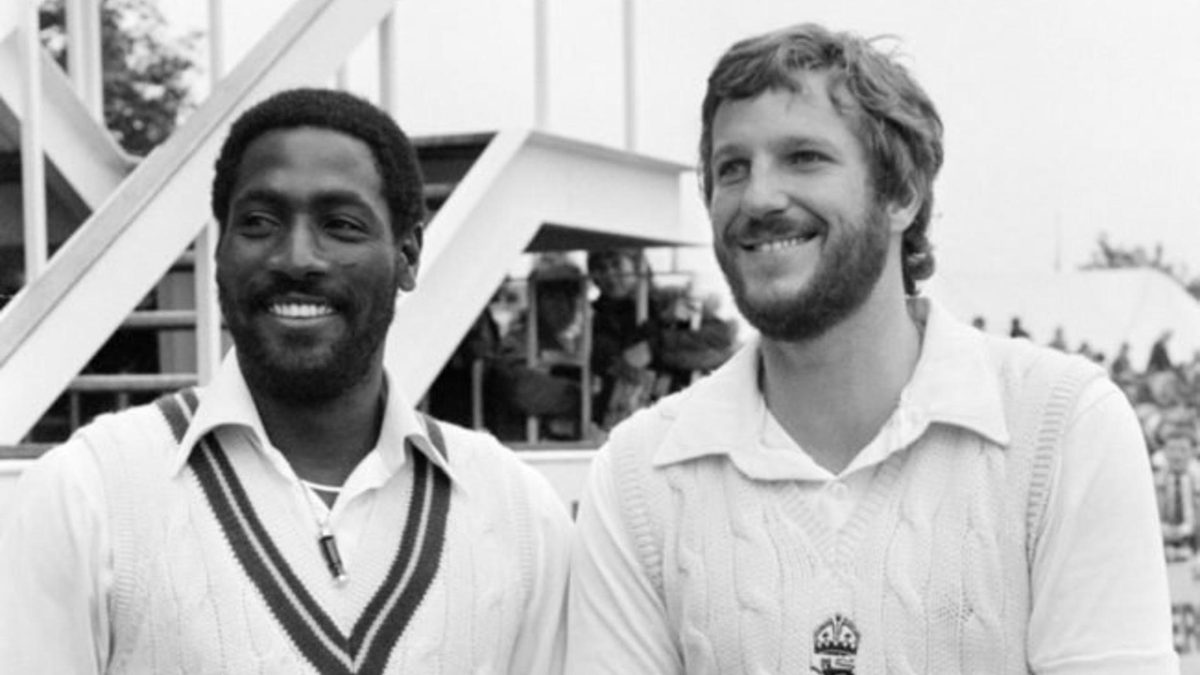
In the 1994 Wisden Cricketers’ Almanack, esteemed cricket writer John Woodcock paid this wonderful tribute to Ian Botham and his great pal Viv Richards after the legends bowed out of the first-class game the previous summer.
John Woodcock was cricket correspondent of The Times from 1954 to 1987 and editor of Wisden from 1981 to 1986.
With the retirement last season, within a few weeks of each other, of Ian Botham and Vivian Richards, first-class cricket lost two of the greatest of all its stars. Botham and Richards were good companions.
Brought together by cricket, they became firm enough friends to spend a part of their winters going round the halls, exchanging banter with much the same abandon as they showed on the field. They had no particular talent for the stage, I think; but their prowess as cricketers deserves to be remembered for as long as the game is played.
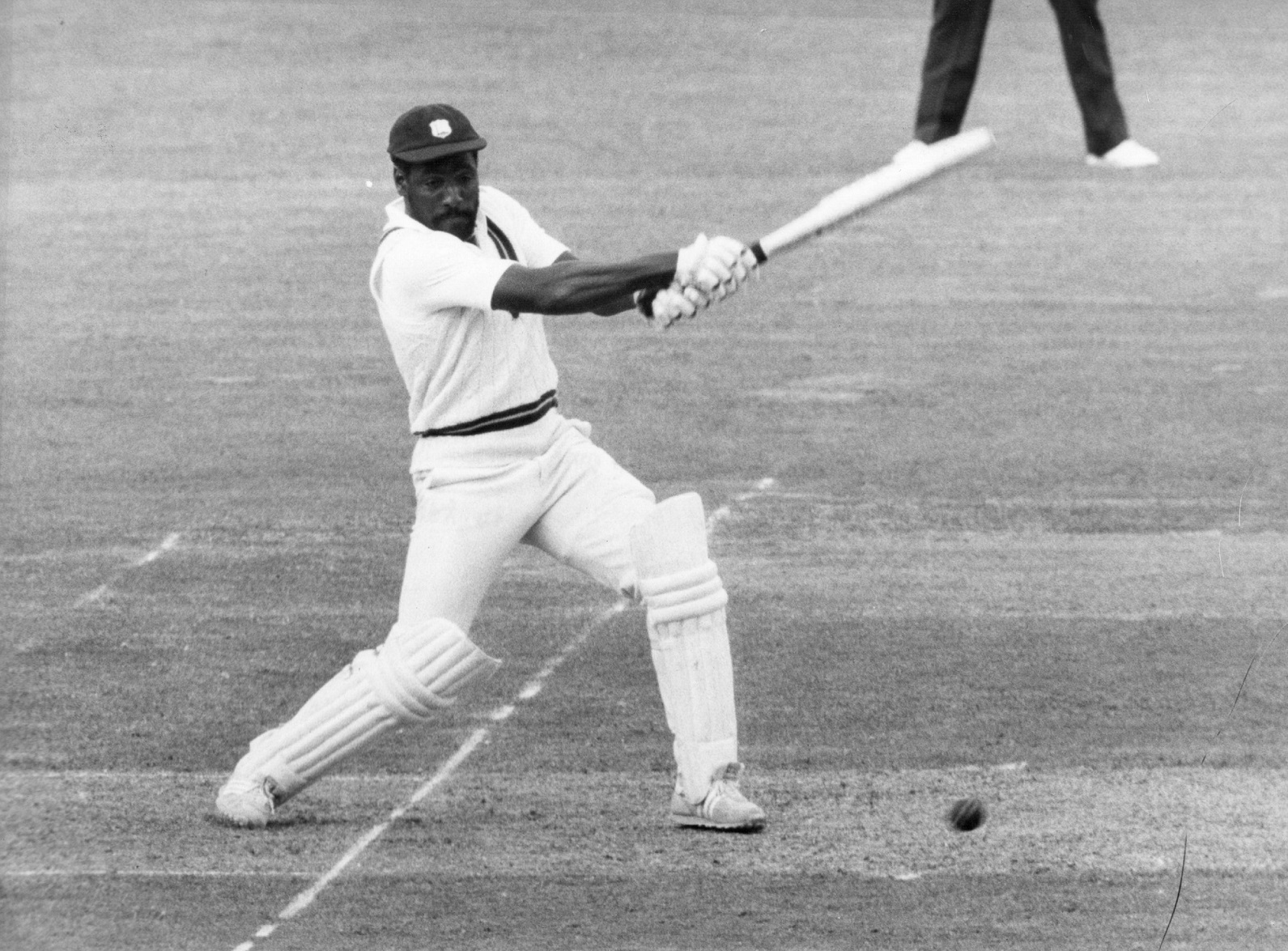 Viv Richards in action against England in a Prudential Trophy ODI at Lord’s
Viv Richards in action against England in a Prudential Trophy ODI at Lord’s
Before Richards, Antigua had yet to be recognised as a nursery of prodigiously talented cricketers. That it now has a Test match ground and a quarter of a million tourists a year owes much to Richards. If Nelson put Antigua on the map by making it the base from which he sallied forth to do battle with the French in the Caribbean, Richards came to glamorise it by looking and batting as he did. He had the countenance to go with his style.
Richards first came to our notice in February 1974, when, playing for the Leeward Islands, he treated the bowling of Mike Denness’s MCC side with dazzling disdain. A contract with Somerset soon followed, then the first of his 121 Test matches.
Such was the impact he made and the conceit with which he played that when Clive Lloyd was looking for a way to counter the ascendancy of Lillee and Thomson in Australia in 1975-76 he sent Richards in first in the last two Test matches. Richards responded by making 30, 101, 50 and 98, and cutting a rare dash as he did so.
In 1976 alone he scored 1,710 Test runs (just think of it!) at an average of 90, culminating in an innings of 291 against England at The Oval – and he was still only 24.
 Ian Botham (c) and Graham Stevenson (l) share a joke with Viv Richards: West Indies v England, third Test, Barbados
Ian Botham (c) and Graham Stevenson (l) share a joke with Viv Richards: West Indies v England, third Test, Barbados
For most of the next two years Richards was lost to Test cricket while on the road with the Packer Circus. There was an intolerance, a belligerence about the way World Series Cricket was played which either hardened its adherents or flustered them. In the event, it confirmed Richards’s supremacy. In a way, it made a man of him.
Ian Botham, meanwhile, was fast becoming the talk of English cricket. He was very strong, patently irrepressible and cheerfully insubordinate. By the time Richards joined Somerset in 1974, Botham, although almost four years his junior, was already on the staff there. They made a flamboyant, ultimately ungovernable pair. After a while Somerset hardly knew what had hit them.
Botham played the first of his 102 Test matches against Australia at Trent Bridge in July 1977, when he was 21. By the end of his fourth he had taken five wickets in an innings three times, made the first of his 14 Test hundreds and run out his captain, Geoffrey Boycott, because he thought he was scoring too slowly if the match, against New Zealand at Christchurch, were to be won (which, eventually, it was).
Within two years and one month Botham had scored 1,000 runs and taken 100 wickets in Test matches – no one has ever done that in a shorter time – and was well on the way to becoming a sporting legend.
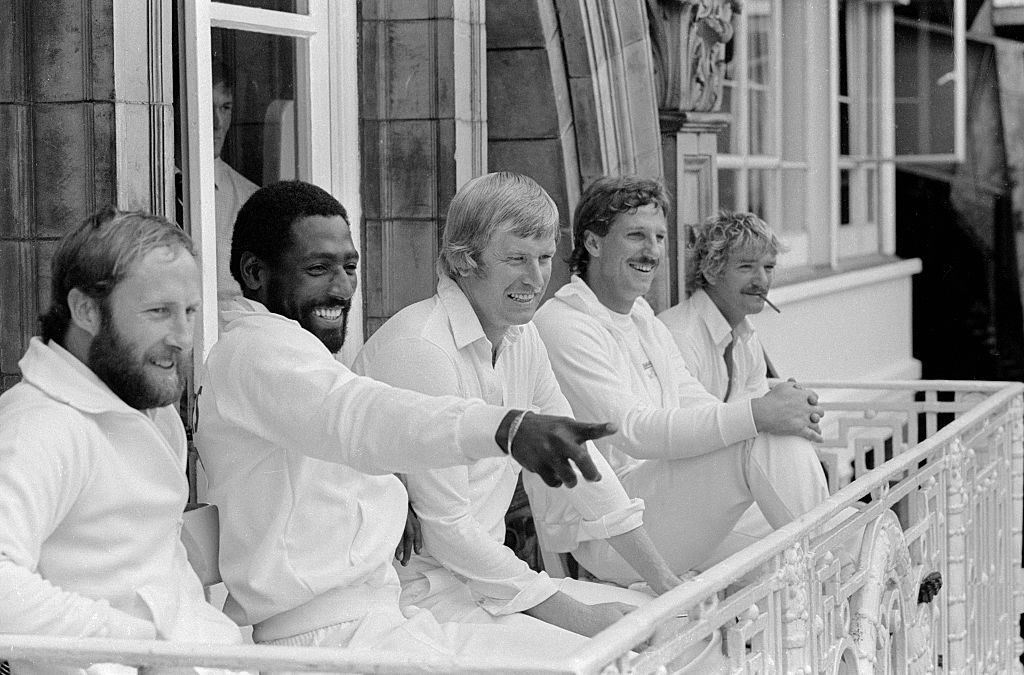 Somerset players Vic Marks, Viv Richards, Brian Rose, Ian Botham and Peter Denning on the dressing-room balcony, July 1982
Somerset players Vic Marks, Viv Richards, Brian Rose, Ian Botham and Peter Denning on the dressing-room balcony, July 1982
Richards was a wonderful batsman. In saying that there has probably never been a more intimidating one, I have not forgotten W.G., who, like Richards, was known to unnerve umpires as well as bowlers and fielders, quite apart from his own partners.
Antigua’s first cricketer to make a name for himself was Danny Livingstone, who became the island’s chief coach after a playing career with Hampshire. I once asked Livingstone whether there was a potential Richards born in Antigua every week or every year or perhaps every ten years. “Maybe every 50 years”, came the reply.
It was not unusual for Richards to whip his first ball through mid-wicket for four, even when it was pitched precisely where the bowler had intended. He had the confidence which came of knowing that he was a symbol of West Indian cricketing dominance, the footwork with which the great natural batsmen are born, the power of lightning and bewildering reflexes. When he was in prime form the best bowlers were as helpless against him as all the rest.
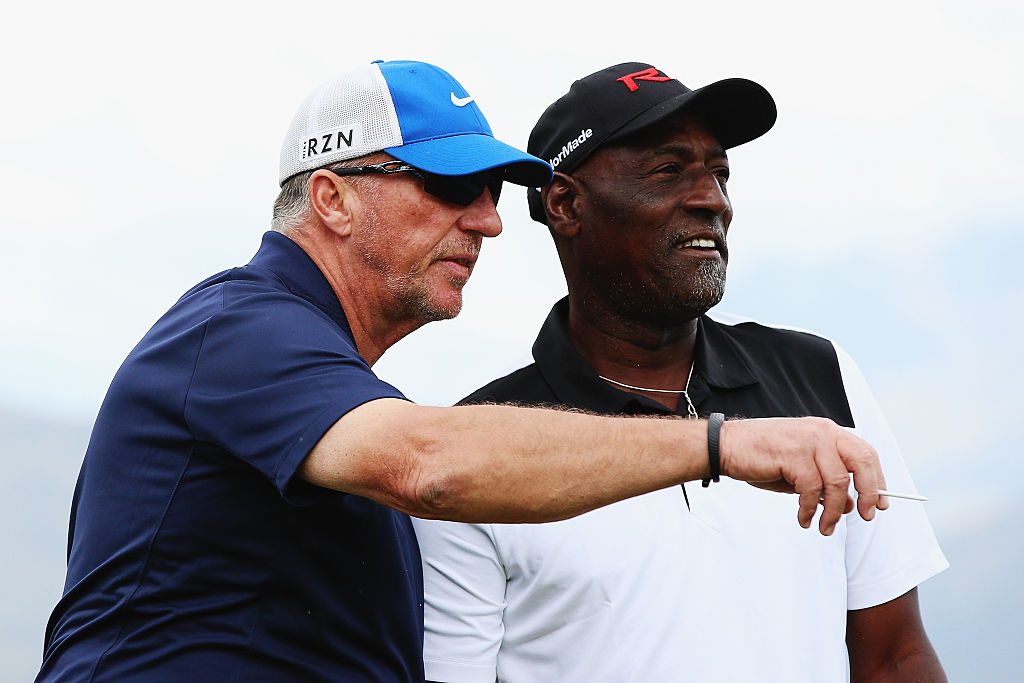 Sir Ian Botham and Sir Viv Richards remain great friends to this day
Sir Ian Botham and Sir Viv Richards remain great friends to this day
After seeing Richards land a straight drive off Greg Matthews, Australia’s off-beat off-spinner, a good 40 yards out of the Bourda Oval in Georgetown in 1991, I wondered whether he had ever made a bigger hit. Yes, he thought there was one against Sussex that beat it – another straight drive, this time off John Snow, which all but cleared the block of flats at the sea end of the county ground at Hove.
His blazing, unbeaten 110 in 58 balls against England in Antigua in 1986 contained seven sixes, none slogged yet all bludgeoned. In terms of balls received it was comfortably the fastest Test hundred ever made.
Botham’s broadsides were less calculated but every bit as spectacular. His deeds against Australia in three successive Test matches in 1981 – at Headingley, Edgbaston and Old Trafford – were miraculous. Three times, with the Ashes in the balance, he snatched victory from the jaws of defeat.
If his 118 in the Fifth Test at Old Trafford was even more stupendous than his 149 in the Third at Headingley that is only because it was more measured – and he still went from 28, when Australia took a new ball, to 100 in not much over half an hour with Dennis Lillee doing his best to stop him. Of its kind it was arguably the finest innings ever played.
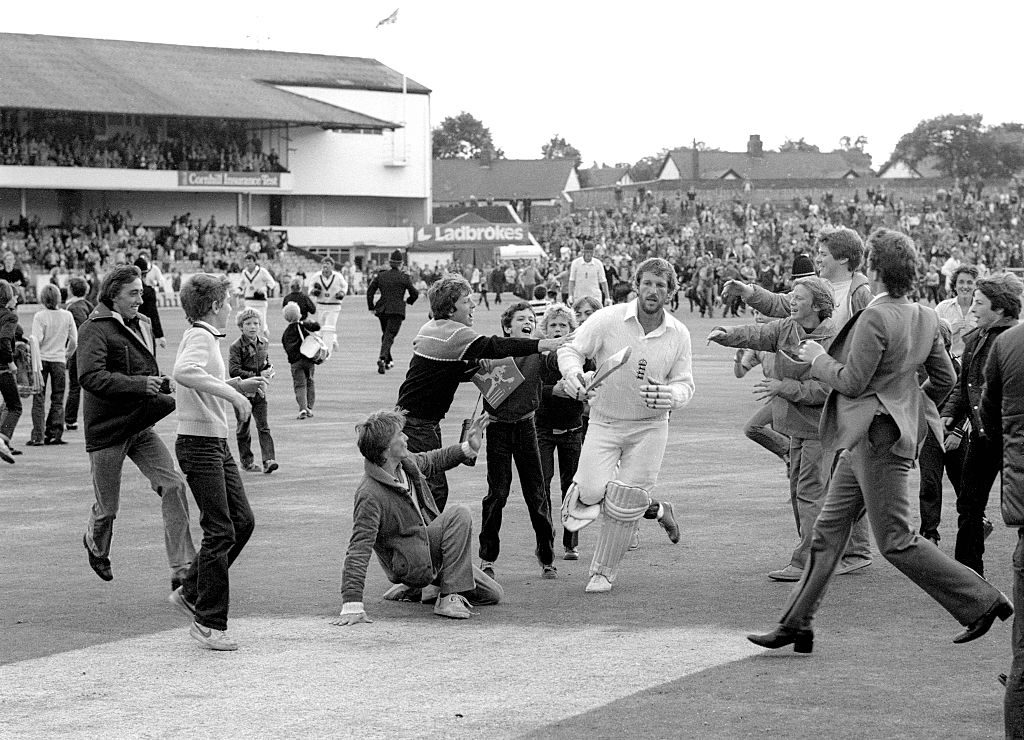 Botham leaves the field at the end of the fourth day during his innings of 149 not out in the third Ashes Test at Headingley, July 1981
Botham leaves the field at the end of the fourth day during his innings of 149 not out in the third Ashes Test at Headingley, July 1981
Not since Gilbert Jessop’s 104 against Australia at The Oval in 1902 had such hitting been seen in a Test match. Jessop hit 17 fours off 76 balls; at Old Trafford Botham hit six sixes and 13 fours off 102 balls; at Headingley a six and 27 fours off 148 balls.
To the man in the street Botham became an idol. He was as much of a sporting drawcard as Don Bradman had been, or Muhammad Ali. The bigger the occasion the better it suited him, except, to his chagrin, when it came to denying West Indies. In 38 innings Botham’s highest score against them was 81 – his average only 21. He took 61 West Indian wickets, however, including that of Richards seven times.
Botham’s 12 Tests as England’s captain, from June 1980 to July 1981, were not among his happiest; but nine of them were against West Indies, and as Mike Brearley’s counsellor-in-chief he had shown himself to be a good reader of the game. I suppose we should have known that it was asking too much of him to captain the side as well as doing so much else.
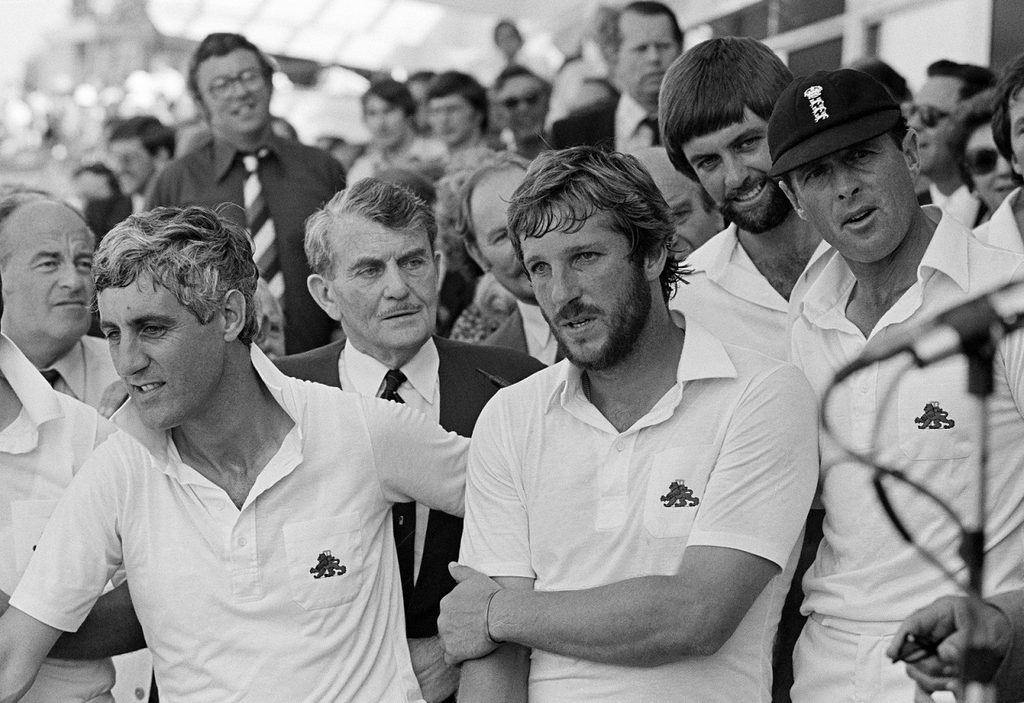 Mike Brearley, Ian Botham, Peter Willey and Geoff Boycott listen to the presentation ceremony, fourth Test, 1981 Ashes
Mike Brearley, Ian Botham, Peter Willey and Geoff Boycott listen to the presentation ceremony, fourth Test, 1981 Ashes
Only Allan Border, Greg Chappell and Richards have held more than Botham’s 120 catches in Test cricket. The great majority of Botham’s were taken at slip, where, contrary to accepted practice, he insisted upon standing only slightly crouched and with his hands on his thighs even when the ball was being delivered.
Then there was the little matter of his 383 Test wickets. Not even Garfield Sobers had an all-round record much superior to Botham’s.
Ian’s bowling varied according to the state of his fitness. As a colt he was uninhibitedly aggressive and a brisk fast-medium. He came charging in off a longish run, taking wickets with a splendid out-swinger when he pitched the ball up and knocking back the bat when he dug it in. As time went by, wear and tear took their toll, though never of his enthusiasm.
For his last five or six years he had to rely more on ingenuity then strength, and not least on make-believe; but even then something very often turned up, if only a catch to long leg off a long-hop. It is fashionable now, I am afraid, with short-pitched bowling so prevalent, for a bowler to station two long legs, and it was Botham who set the trend.
Even when he was merely ambling up to the wicket and bowling at the gentlest of paces, he did more than anyone to help England beat Australia at Sydney in the 1992 World Cup, taking 4-31 in his ten overs and then making 53 going in first. But his batteries were pretty nearly run down by then, and once the England selectors were no longer interested in him they went flat. Despite containing the last of his 38 first-class hundreds, for Durham against Worcestershire at Stockton, his final days were more melancholy than misty-eyed.
Armed with today’s heavy bats, Botham and Richards hit the ball as hard and far as it can ever have been hit. At times when they were batting together, two or three balls might be seen floating like flotsam in the River Tone, which made it all the sadder when their years with Somerset ended not in the laughter which they liked to evoke but in mounting acrimony.
The rights and wrongs of that dispute were too well-rehearsed at the time to need repetition here. Let it suffice to say that a parting of the ways was in Somerset’s best interests.
Botham’s brushes with authority, whether they concerned cricket or the law, in England or elsewhere, may have been evidence of a free spirit, but they were really no more excusable for that. Richards, for his part, had a temper to contend with, which was behind a swingeing two-year suspension, imposed in his late teens, from playing cricket in Antigua, and was another reason for his being held in fairly universal awe.
It seemed to me that over the years the press generally exercised discretion in favour of both players, though I doubt very much whether they would subscribe to that view themselves.
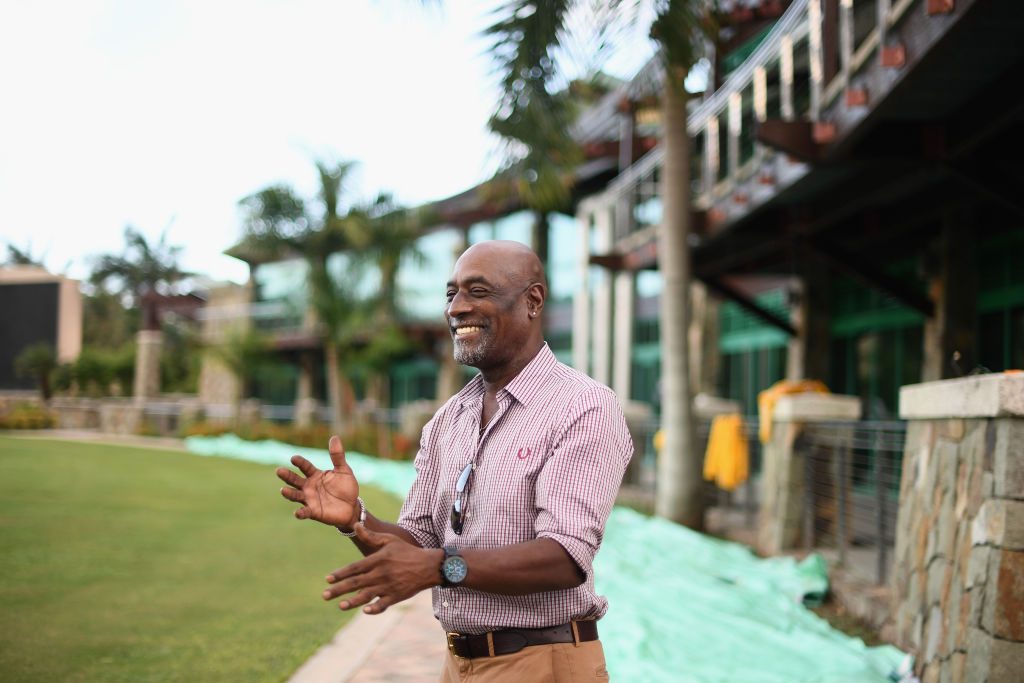 Sir Vivian Richards has this week been promoting the Women’s World T20 in Antigua
Sir Vivian Richards has this week been promoting the Women’s World T20 in Antigua
To Botham the colour of a man’s skin was of small account. To Richards it mattered much more; more, sometimes, than was helpful. Botham was quite without artifice. You got what you saw. Richards was proudly and defiantly black. The swagger with which he walked to the wicket, flashing that Rastafarian wristlet; the air with which he looked round the field, the conviction with which he twiddled his bat, the condescension with which from time to time he failed, were all a part of one of the supreme acts in the history of the game. He was stamped with the image of a king. As he ruled, so too he raged, and so, in his tranquil moments, he responded to affection.
Viv was a hard cricketer, but a chivalrous, warm-hearted and unselfish one. In the years of his maturity his love of the game and still-unwavering determination inspired Glamorgan to a season to remember. Botham was just as fiercely competitive, just as chivalrous and chauvinistic, and just as contemptuous of averages.
His marathon walks undertaken to raise funds for leukaemia have been magnificent, and reflect an abundantly generous spirit. He, too, “sounded forth the trumpet that shall never call retreat”. They are two of the immortals, and it is an honour to salute them as such.








